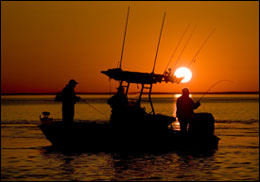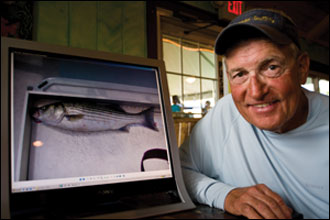|
The Case against Fishing Menhaden

Photograph by Jay Fleming.
WHO GETS FIRST CALL THEN ON THE MENHADEN BOUNTY of the Chesapeake Bay? Omega Protein? The snapper rigs? The striped bass that fishermen like to catch? The ospreys and eagles that sometimes fight over the fish?
Ed Liccone would leave most of the menhaden as food for striped bass and other predators. He's chairman of the Maryland chapter of a sportfishing group called the Coastal Conservation Association (CCA), and he's showing me a photo of a striper that was well fed enough to win him a third place in the organization's spring tournament. Liccone is showing a photo, not a fish, because he let his fish go. The CCA spring tournaments are catch and release. "We are sportsmen who are trying to protect the resource," he says, summarizing what seems to be the official stance of many sportfishing groups.
"We think the marine predators have first call on this resource," agrees Jerry Benson, vice president of the Virginia chapter of the Coastal Conservation Association. "Is that unreasonable? They depend on that for life itself. It's not a profit deal for them." A stocky man with graying hair and beard, and a ruddy, friendly face, Benson speaks calmly, even quietly, but his organization is one of the loudest voices pushing for cutbacks on commercial harvesting by Omega Protein in Reedville.
"To have a healthy ecosystem," he says, "you need more menhaden in the water." It's a concept straight out of ecosystem-based fisheries management, and in their campaigns for cutbacks, sportfishing groups like Benson's have been consistent advocates for this kind of science-based approach. Findings from fishery science, however, have not always helped their cause.
In their 20-year push to rein in commercial fishing for menhaden, sportfishing groups built a case based on three claims: That the accidental bycatch in menhaden nets was probably killing a lot of other fish. That the filtering power of huge schools of menhaden could help clean up water quality in the Chesapeake. That the forage value of menhaden as food fish for other species, both fish and fowl, made it a keystone species in the Bay's ecosystem. As rallying cries against commercial harvesting, the claims carried emotional power that was obvious and considerable.
Of all these issues, accidental bycatch sparked the most emotional response from recreational fishermen. Anyone who came upon the spectacle of spotter planes, big ships, and seine boats all working together to circle and trap a huge school of struggling, splashing menhaden could angrily assume — and many did — that those nets were also swallowing up a lot of striped bass and bluefish and sea trout.
It's an assumption that doesn't die easily or quietly. When three scientists from the Virginia Institute of Marine Science (VIMS) mounted a major study in 1992, however, they found little evidence of large bycatch. The number of other fish in menhaden nets averaged less than 0.21 percent — or 1 fish in 500. That meant more than 99.7 percent of the fish in commercial nets were menhaden.
It was a finding based on 43 net sets observed and sampled by a science team led by Herb Austin, Jim Kirkley, and Jon Lucy. They rode the big menhaden ships and the smaller net boats and worked the unloading docks of Zapata Haynie, the company that later became Omega Protein. While all those net hauls on Zapata boats brought in over 2.5 million menhaden, they trapped only 5,337 non-menhaden fish. Spanish mackerel was the most numerous bycatch, followed by bluefish, croaker, hogchoker, and sea trout.
That research finding raised immediate outrage from many in the sportfishing community. "They said we were hoodwinked," says Jon Lucy, a retired Virginia Sea Grant extension agent with a long history of working with recreational fishermen. The criticism quickly got personal, says Lucy. "It was like I had slapped a hornet's nest." According to Kirkley, complaints flooded his email and his phone line, many of them cussing him out. "They said we were on the take. They accused me of being on the [Zapata] payroll, of forging the results," said Kirkley. "That went on for a good long time."

With this striped bass, caught near the mouth of the Choptank River, Ed Liccone won 3rd place in the fly-fish division of the annual spring catch-and-release tournament sponsored by the Maryland chapter of the Coastal Conservation Association. Now chairman for the association, Liccone says he probably catches 2,000 striped bass a year. And keeps two. Photograph by Michael W. Fincham.
Concern about bycatch already had a good long history. Surprisingly, the results by the VIMS team nearly matched a finding from 100 years earlier. In 1894, the U.S. Fish Commission organized a similar, though much larger, study of menhaden bycatch, placing federal agents aboard menhaden boats for two to three months. They collected samples from 1,078 net hauls that totaled more than 28 million fish. Their finding was the same as the 1992 study: 99.7 percent of the fish in the nets were menhaden.
Also taking a hit from recent research is a second, perhaps more popular claim: that menhaden are helping clean up water quality in the Chesapeake. It was an idea based on biology and hope. Menhaden are filter feeders: They catch phytoplankton as they pass through their gills. That was the biology. Perhaps, like oysters, they could help cut down the overabundance of phytoplankton, reduce nitrogen levels, and shrink the size and frequency of dead zones during summer months. That was the hope. Menhaden swimming in the water, oysters sitting along the bottom — rebuilding stocks of these natural filters could deliver a one-two punch against nitrogen pollution in the Chesapeake Bay.
What if all the menhaden now fished out of the Bay were left in the water? What effect would that have on water quality? The question was interesting enough to draw research funding from three environmental organizations: the Chesapeake Bay Foundation, the Nature Conservancy, and the Keith Campbell Foundation for the Environment. When they funded studies by Patrick Lynch, Mark Brush, and Rob Latour, however, the scientists came up with answers last year that the sponsors never expected.
Working at VIMS, the researchers collected menhaden from cast nets and pound nets and released the fish into six large, circular tanks filled with water from the York River. Then they watched what happened. With plenty of plankton in the river water, the scientists were able to monitor any changes in phytoplankton and nitrogen resulting from menhaden feeding. They also estimated the feeding rates of menhaden at different ages and sizes and then calculated the impact that leaving 109,000 tons of menhaden (the maximum allowable catch) would have on water quality in the Bay. That led to a lot of math and a lot of modeling based on different assumptions.
The result: The menhaden in their tanks did not have a measurable impact on the phytoplankton concentrations and nitrogen levels. Under certain conditions, menhaden could add nitrogen through their own fecal waste. If all the menhaden taken out of the Bay by fishermen were left in the Bay, the effect on water quality would probably be "more or less negligible." That was "our best educated guess," said Rob Latour, one of the lead scientists for the VIMS study.
The "negligible impact" finding was surprising, admits Bill Goldsborough, senior fishery scientist with the Chesapeake Bay Foundation, one of the major funders of the research. For both Goldsborough and Latour, there was another, unexpected lesson coming out of this research on menhaden feeding patterns: The negative impact of nitrogen pollution on the Chesapeake was even greater than previously thought.
Here's the ecology: Estuaries that have been degraded by nitrogen overloads could see the evolution of phytoplankton species that are smaller in size. "One working hypothesis," says Latour, "is that we have altered the phytoplankton community." And here's the biology: Smaller-sized phytoplankton may pass right through the gills of adult menhaden. Some of those tiny phytoplankton will be caught by smaller, juvenile menhaden, creating a small but real filtering effect. But when menhaden grow larger, the space between their fingerlike gill rakers grows wider, most small phytoplankton pass straight through — and the filtering effect goes away.
The result, according to Goldsborough, is "a triple whammy" delivered by nitrogen pollution. Nitrogen overloads the system with plankton, leading to dead zones. It creates smaller plankton species. And it negates menhaden as a natural filter. In a healthier estuary featuring less nitrogen and larger phytoplankton, schools of menhaden could play a dominant role in controlling phytoplankton abundance. In a degraded estuary, they play a diminished role.
The negative findings about the filtering power of menhaden have stirred up some dissent. "I doubt that is totally true," said Benson of CCA. "If there were ten times as many menhaden, I think they would suck up a lot of stuff." But there has been none of the outrage (at least not yet) that followed the earlier bycatch studies. "We don't use that [filtering] argument any more," says Benson. "We used to, but there is no point in putting forth an argument that someone has accounted for."
One argument left standing, one argument that sportfishermen and scientists can agree on, is the role menhaden play as an essential link in the Bay's food webs. "They convert plankton energy to higher trophic energy," says Dave Secor, a fishery researcher with the Chesapeake Biological Laboratory. When they are abundant, they convert zooplankton and phytoplankton to a food form that dozens of fish and waterfowl species can feast on. "They are," he says, "incredibly efficient and important."
— Michael W. Fincham
|